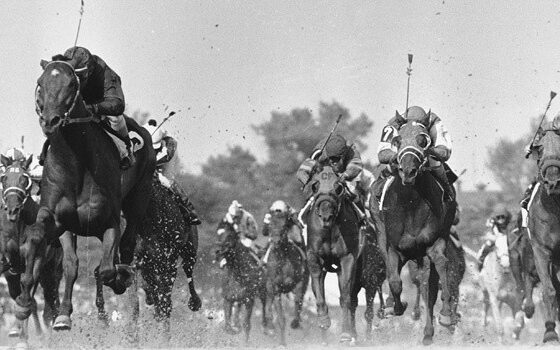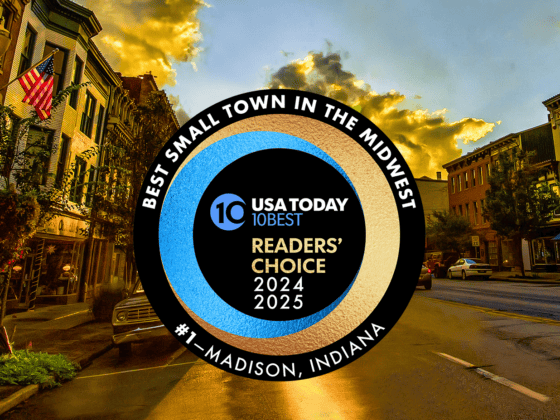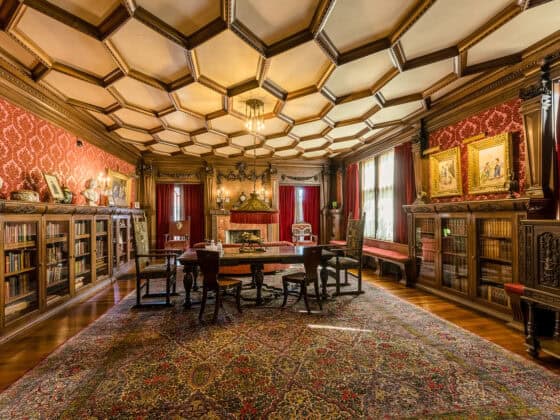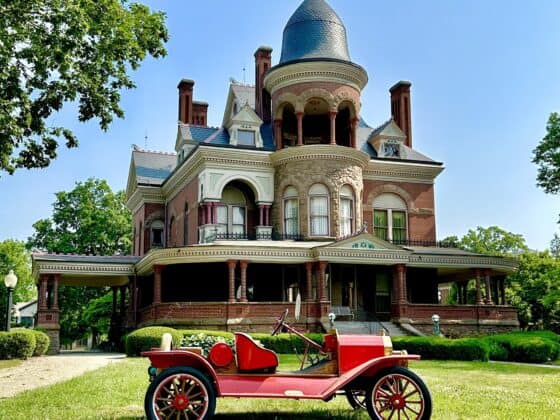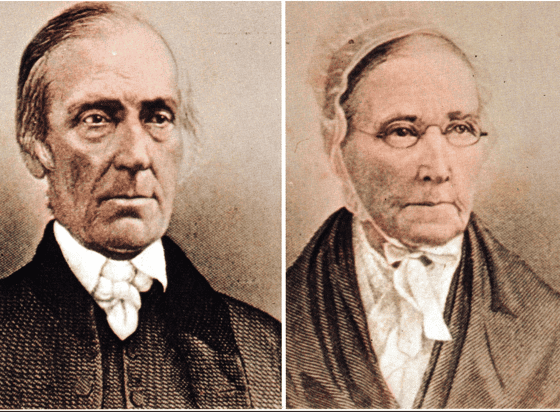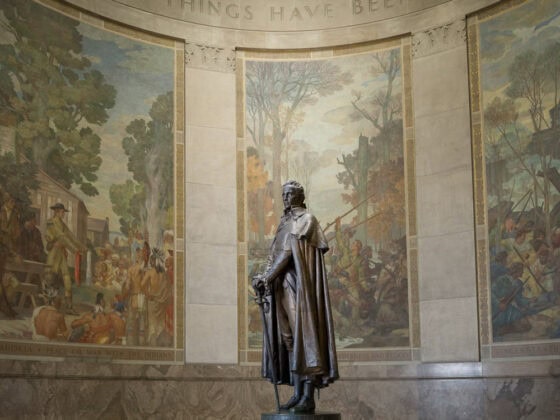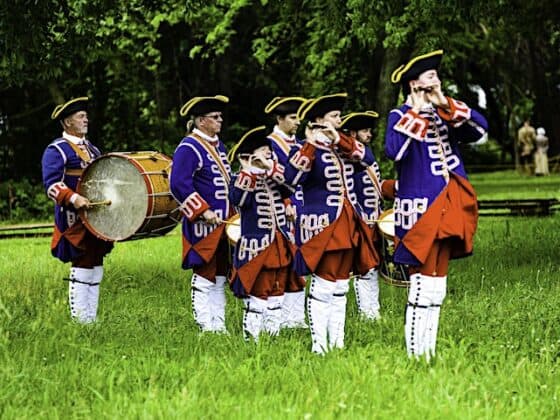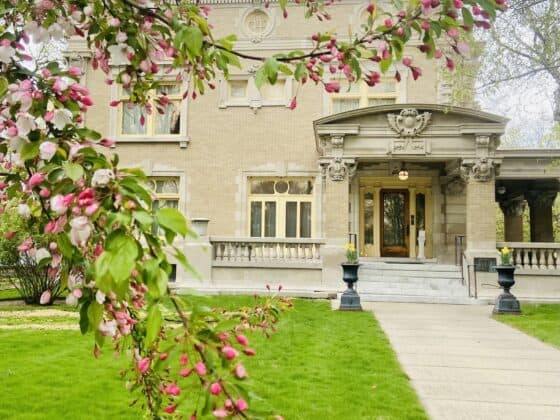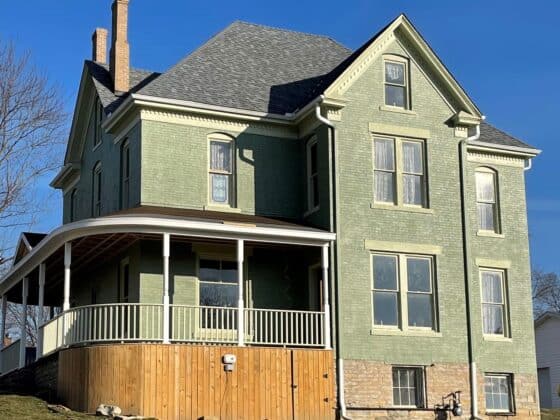By Jane Ammeson
When Abraham Lincoln stopped at the Noon Day Inn in 1844, the stage stop in Haubstadt had already been serving travelers for almost 20 years, having opened in 1825, making it the oldest restaurant in continuous operation in Indiana. Now expanded many times over and called the Log Inn, one section of the interior with its original hewn log walls and chinking still is much as it was when Lincoln came to dine and where drivers changed horses on the 21-hour journey (if the weather was good) between Evansville and Vincennes—a trip that now takes about an hour by car.
So popular for their family style chicken, ham or beef dinners served with mashed potatoes, gravy, choice of two vegetables, slaw, hot rolls and butter as well as other ala carte menu items like French fried shrimp, catfish and a wonderful selection of killer desserts the line often starts to form an hour before opening.
While waiting for the Log Inn to open at 4:00 pm, feel free to tour the Gibson County Barn Quilt Trail, with over 225 bar quilts; or the Azalea Path Arboretum and Botanical Gardens in Hazelton, a 60-acre park where more than 3,000 colorful azaleas bloom each spring.

Said to be one of the largest collections of azaleas in the Midwest, the botanical gardens, with its two spring-fed lakes, waterfall, koi pond, three miles of walking paths, chainsaw carvings and sculptures, also is home to native and imported trees and many unique plants.
We can’t pinpoint other places still in business where Attorney Abe might have dined, but there are plenty of historic eateries in the state to construct a perfect road trip for foodies.
Founded in 1834, the Historic Broadway Hotel & Tavern in Madison is Indiana’s oldest continuously operating tavern in the state. Right now the hotel is closed for renovations (though owner Libby Mann has a bed and breakfast in a historic manor nearby) but the restaurant keeps busy serving a wide array of items from sandwiches and soup to steaks, fish, pasta and chicken, as well as ribs and chops. Each fall, Mann buys pounds of persimmons from area growers and pulps them to make persimmon pudding using her mother’s recipe.
“It won first prize for eight years in a row at the Persimmon Festival in Mitchell,” says Mann proudly.
“It’s a Dutch-German thing,” says Marta Hollen who purchased the Hilltop Inn in Evansville from her parents last year. Also a stage coach stop on the Wabash to New Harmony line, the three- story brick building was built in 1839. On the main floor was the saloon (hey, a tired traveler needed a drink or two, you know) and dining room on one side and a general store/feed store on the other with rooms for sleeping on the upper two floors.
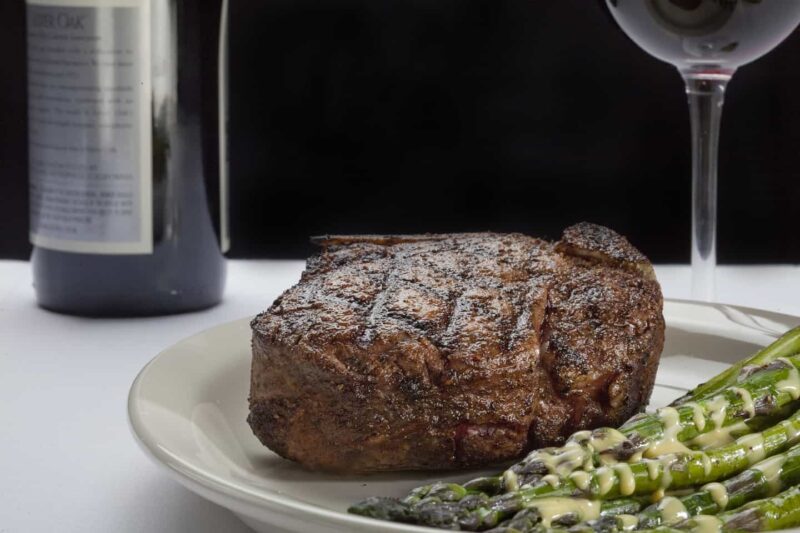
The ”Dutch-German thing” Hollen is referring to is their specialty— fried brain sandwiches which has earned them national acclaim. Of German and Dutch heritage herself, Hollen took the whole brain thing into the 21st century with brain sliders but when she starts talking about two-inch scoops, we decide to just focus on the sandwich itself and not how it’s cooked. And yes, they really are like Hollen describes them—crisp on the outside and fluffy inside.
In the oh-so Germanic town of Oldenburg, German fare is also part of the heritage of two restaurants—the Pearl Street Pub which opened in the 1850s as the King’s Tavern and the relatively new Bavarian-style Braus Haus which is just 96 years old.
The Slippery Noodle Inn, Indiana’s oldest bar, has had several names since first opening as a railroad hotel called the Tremont House in 1850 on South Meridian Street in Indianapolis, offering guests good, drink and a place to stay. A stop on the Underground Railroad (yes, it’s haunted), it’s now owned by Hal Yeagy whose parents bought the place in 1963. The large rambling building hosts two areas where bands perform, as well as the original bar room, a glassed-in dining area, and several side rooms. The menu is extensive and foodwise there’s something for everyone including those just looking for good bar grub to enjoy while listening to music to entrees like steak, pasta and chicken.
The oldest restaurant in Indianapolis, the Rathskeller, has been serving traditional German cuisine since 1894. Located in the Athenaeum, the massive brick Romanesque-Revival building on trendy Mass Avenue was designed by noted Indy architect Bernard Vonnegut, grandfather of author Kurt.
Eight years later in 1902, a restaurant that wasn’t German (as far as we known) opened in downtown Indy. Now a landmark, St. Elmo’s is the oldest Indianapolis steakhouse in its original location. And besides great cuts of meat, their shrimp cocktail is on the level of a national treasure. Also in Indianapolis and celebrating their 99th year, Workingman’s Friend dates back to 1918. While the unassuming exterior isn’t necessarily pretty, the burgers, fries, chilies and onion rings are sublime.
But enough with the 20th century, let’s backtrack to the 1900s again. It’s country cooking with heaps of fried chicken and their famous fried biscuits (don’t ask about the calories because you really don’t want to know) served with apple butter at The Nashville House, Brown County’s first restaurant, which opened in 1859 and was also a place to spend the night. The original building burned down in 1943 but the “new” place still retains that old time country charm.
Established in 1878 in tiny Avilla near Fort Wayne, the St. James is considered the oldest restaurant in Northern Indiana. The exterior, though extensively restored, is just as charming as it looks in vintage photos when it was a hotel with a dining room on the main floor. Here again you’ll find German fare with dishes such as Jagerschnitzel (pan-fried pork cutlets in a mushroom sauce) and bratwurst all served with red cabbage and a choice of spatzle, potato pancakes or German potato salad and a choice of soup or salad.
Last time we looked, there were no oceans near Fort Wayne but that doesn’t stop the Oyster Bar, a rambling restaurant dating back to 1888 from serving a wide variety of seafood including, you guessed it, oysters in many variations—on the half-shell, fried, Rockefeller, Jalapeno Casino, Bienville, Parmesan Baked and Black & Bleu.
While you’re in Fort Wayne, consider a stop at the relatively new Coney Island Weiner (1914), the oldest Coney stand in America. Long time locals say it hasn’t changed—the same Coney and chili recipes and steamed buns.
An ice cream parlor and diner since 1900, Zaharakos in downtown Columbus has an amazing interior—all gold, marble, Tiffany and a side room filled with the largest collection of pre-1900 marble soda fountains on public display.
Indiana’s famed deep fried pork tenderloin sandwiches originated at Nick’s Kitchen in Huntington. The place started off as a hamburger stand in 1904 run by Nick Freienstein who saved enough money to open up a restaurant in 1908. It’s his recipe that’s still used today.
The Olympia in Goshen opened as a candy store with a soda fountain in 1912 and in 1920, and a diner was added by Nicholas Paflas, a Greek immigrant. Currently Nick’s great-granddaughter owns the business. One of the original menu items, the nut olive sandwich (chopped green olives and roasted cashews on toasted bread) is still being served.
Finally, we’re not sure where to put the Yellow Tavern, a beautiful building with Palladian-style windows and a Moorish front, located in wonderful New Harmony on the Wabash River. It first opened in 1815, burned down in 1908 and has now reopened in another historic building. Is it old or new, we’ll let you decide?



